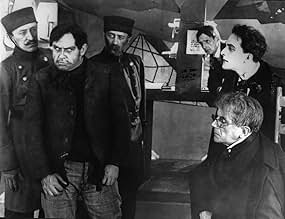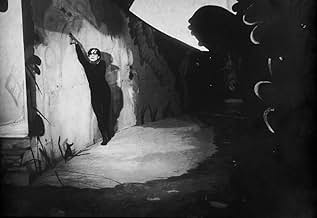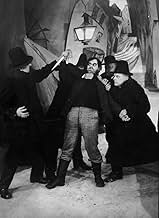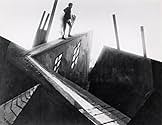VALUTAZIONE IMDb
8,0/10
73.256
LA TUA VALUTAZIONE
L'ipnotizzatore Dott. Caligari utilizza un sonnambulo, Cesare, per commettere omicidi.L'ipnotizzatore Dott. Caligari utilizza un sonnambulo, Cesare, per commettere omicidi.L'ipnotizzatore Dott. Caligari utilizza un sonnambulo, Cesare, per commettere omicidi.
- Premi
- 2 vittorie e 1 candidatura in totale
Friedrich Feher
- Franzis
- (as Friedrich Fehér)
Hans Heinrich von Twardowski
- Alan
- (as Hans Heinz v. Twardowski)
Rudolf Lettinger
- Dr. Olsen
- (as Rudolph Lettinger)
Rudolf Klein-Rogge
- Ein Verbrecher
- (non citato nei titoli originali)
- …
Hans Lanser-Ludolff
- Ein Alter Mann
- (non citato nei titoli originali)
- …
Henri Peters-Arnolds
- Ein Junger Arzt
- (non citato nei titoli originali)
- …
Ludwig Rex
- Ein Mörder
- (non citato nei titoli originali)
- …
Elsa Wagner
- Die Wirtin
- (non citato nei titoli originali)
- …
Recensione in evidenza
This movie was shot between 1919 and 1920, a few decades since the motion picture camera was invented, and the Lumière brothers were in the middle of their experiments with it. At the time, cinema was being considered as a new way of making art, and yo make art you had to marry with a serie of ideas: ideology, aesthetics, cosmogony, etc. In these terms, this movie belongs to the German expressionism, which is reflected in the entire setup: from characters make up to the background of the set.
Having an average murder-mystery plot, the movie can be defined as a painting with some action occurring in it. The whole scenario was displayed following the same criteria as in expressionist painting: all diagonal and curve lines, evading the straightness and the cardinal orientation of things, wicked perspectives and proportions. Even the more minimum detail was carefully considered to fulfill the aesthetics needs. The result couldn't have been better, considering that the only visual trick they could do was to shrink/enlarge the camera's diafragma. Think that this was before the concept of travelling was even developed.
Concerning the plot, yet it's true that it isn't really the great thing and that many people now a days find it boring, I got to enjoy it, further than its aesthetical function (I even got to laugh in a couple of scenes), and I highly recommend it, as a good old piece of art from which many of today's film makers may take some good lessons on how to approach movies. I'm sure that if they got understand that, then there would be much lesser crappy movies than there are now a days.
Having an average murder-mystery plot, the movie can be defined as a painting with some action occurring in it. The whole scenario was displayed following the same criteria as in expressionist painting: all diagonal and curve lines, evading the straightness and the cardinal orientation of things, wicked perspectives and proportions. Even the more minimum detail was carefully considered to fulfill the aesthetics needs. The result couldn't have been better, considering that the only visual trick they could do was to shrink/enlarge the camera's diafragma. Think that this was before the concept of travelling was even developed.
Concerning the plot, yet it's true that it isn't really the great thing and that many people now a days find it boring, I got to enjoy it, further than its aesthetical function (I even got to laugh in a couple of scenes), and I highly recommend it, as a good old piece of art from which many of today's film makers may take some good lessons on how to approach movies. I'm sure that if they got understand that, then there would be much lesser crappy movies than there are now a days.
Trama
Lo sapevi?
- QuizWriter Hans Janowitz claims to have gotten the idea for the film when he was at a carnival one day. He saw a strange man lurking in the shadows. The next day he heard that a girl was brutally murdered there. He went to the funeral and saw the same man lurking around. He had no proof that the strange man was the murderer, but he fleshed the whole idea out into his film.
- BlooperIn the wide shot, the sign at the asylum reads "Insane Asylum," in English. In the close-up, the sign is written in German (Kino Blu-ray Disc version, may not be present in all editions of the film).
- Versioni alternativeUSA laserdisc reissue restores the original hand-drawn title cards that have been missing from every known print of the film since 1923. When first released on video in the United States, film was in black-and-white, and played back many scenes at double speed and featured different music. Although no scenes were cut out, the running time was reduced to only 51 minutes. The restored version restores the colour-tinting, restores the original title cards, and plays the film back at regular speed, returning the film to its original 69-minute running time.
- ConnessioniEdited into People Who Die Mysteriously in Their Sleep (2004)
I più visti
Accedi per valutare e creare un elenco di titoli salvati per ottenere consigli personalizzati
Dettagli
- Data di uscita
- Paese di origine
- Lingua
- Celebre anche come
- El gabinete del Dr. Caligari
- Luoghi delle riprese
- Azienda produttrice
- Vedi altri crediti dell’azienda su IMDbPro
Botteghino
- Budget
- 18.000 USD (previsto)
- Lordo Stati Uniti e Canada
- 8811 USD
- Lordo in tutto il mondo
- 9297 USD
- Tempo di esecuzione1 ora 16 minuti
- Mix di suoni
- Proporzioni
- 1.37 : 1
Contribuisci a questa pagina
Suggerisci una modifica o aggiungi i contenuti mancanti

Divario superiore
By what name was Il gabinetto del dottor Caligari (1920) officially released in India in English?
Rispondi
















